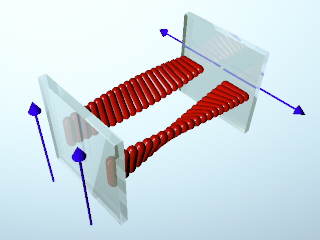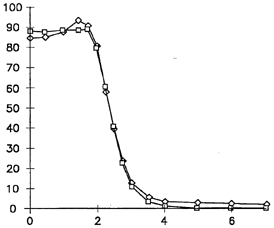Active Domain LCD Shutter
We have recently developed a novel liquid crystal device that can act as an optical diffraction or phase grating. This device is somewhat experimental, however working prototpes have been built and they exhibit the characteristics described below.
This device has been used successfully as a light modulator in a light-valve projector, but has also been suggested as a replacement for a mechanical shutter in certain optical systems.
One of the characteristics of this device is that, unlike most other liquid crystal displays, it does not have polarizers. This allows about 95% of the incident light to pass through the display in its clear state. In its opaque state, less than .5% of the incident light is allowed to pass through the device. A normal LCD only passes about 45% of the light incident on its front surface in its clear state.state.
|
Our device is shown in Figure 1 to the right. It is merely a normal liquid crystal shutter with alternating areas where domains or “stripes” are formed by changing the direction of orientation of the liquid crystal fluid. In our drawing, only two adjacent "stripes" are shown, but the cell is actually made of many such parallel stripes. It can be seen that two parallel light rays, initially in phase and vertically polarized, exit the cell with an effective phase difference of pi radians for the adjacent stripes. The pixel will in theory produce 100% diffraction efficiency with all energy diffracted into the odd orders. |

|
If the output filter is designed to pass the odd orders and block the zero and even orders, the percentage of transmitted light approaches the limit set by the diffraction efficiency. Contrast in such a system can be extremely high.
One of the additional benefits is that the phase shift between adjacent regions of the pixel is approximately 180o regardless of the polarization of the incident light on the pixel. As a result, the device does not require polarizers and their associated light loss.
|
Figure 2 on the right shows the light diffracted by
our test cell into the odd orders as a function of voltage, showing grey scale
operation.
The peak transmission for green light (523 nm indicated by the diamonds) is 94% of the total amount of light transmitted by the cell, and the contrast ratio is 44. For red light (630nm indicated by the squares), the peak transmission is 88% and the contrast ratio is 372. |
 |
The amount of diffraction of our cell is a direct function of the cell spacing of the cell itself. A diffraction of 5o is easy using conventional LCD manufacturing techniques, but this value can be tweaked if necessary for a particular application. If this device is put into an optical system with a relatively narrow (5o-10o) field of view, it could act as a very efficient shutter obviously with no moving parts.
Further improvements in our cell are possible. In particular, the contrast ratio can be improved by adjustments of the LC cell gap, and the size of the LC domains.
I hope that this brief explanation of our “Active Domain LCD Shutter” gives you some idea of its possible applications. Please give us a call at (440)232-8590 and talk to one of our applications specialists about any questions you may have about its use.
